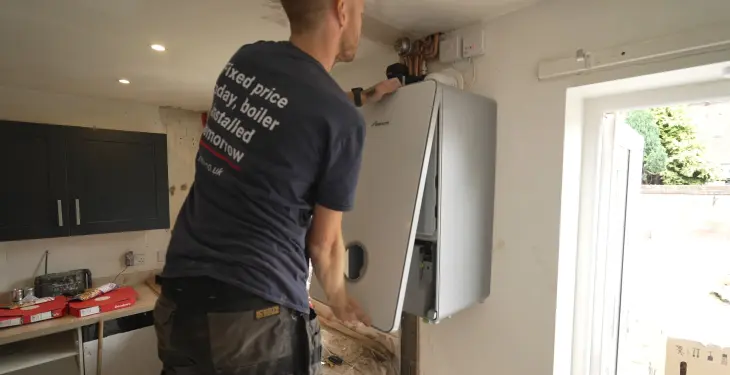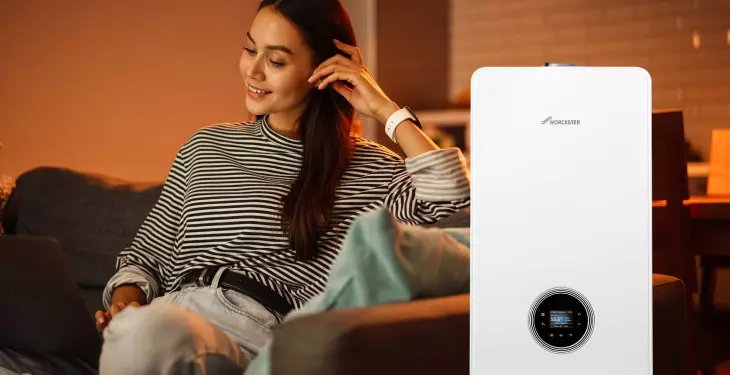

Written by Stephen Day
Gas Safe Engineer
Updated: 30th May, 2025
Understanding the key components of combi boiler pipework is essential for making informed decisions about installation, maintenance, and operation.
Get a new boiler quote, save up to £550 per year (0% APR available).
Understanding the pipework of a combi boiler is essential for anyone looking to install or maintain this popular heating system. A combi boiler, or combination boiler, provides both hot water and central heating from a single unit, eliminating the need for separate water tanks. This unique feature makes it a space-saving option for many homes.
The primary pipes involved in a combi boiler system include the flow pipe, which carries hot water from the boiler to radiators and taps, and the return pipe, which brings cooler water back to be reheated. Additional essentials are the mains water pipe, gas supply pipe, condensate pipe, and boiler flue, each playing a crucial role in the system's functionality.
By understanding these components, homeowners can better appreciate the workings of their heating system and ensure its efficient operation. Regular servicing is crucial to maintain safety and maximise the efficiency of your combi boiler.
A combi boiler, short for combination boiler, is a single unit that provides both hot water and central heating for homes.
Unlike traditional boilers, it does not require a separate hot water cylinder or cold water storage tank, making it space-saving and efficient.
Combi boilers are condensing boilers, which means they condense water vapour in the exhaust gases, improving efficiency and reducing energy costs.
Hot Water On Demand: Delivers instant hot water without the need for a storage tank.
Compact Size: Ideal for small spaces, as it combines heating and hot water in one unit.
Energy Efficient: High efficiency ratings due to the condensing technology.
Heating Element: The boiler heats water directly from the mains when a hot water tap is turned on.
Flow and Return Pipes: Flow pipe carries hot water to the radiators. Return pipe brings cooler water back to be reheated.
Gas Supply Pipe: Provides the necessary gas for heating.
Condensate Pipe: Drains away condensation produced during the heating process.
Pressure Relief Valve: Ensures the system maintains safe pressure levels.
Flue: Expels exhaust gases from the home.
Fast Installation: Simple to install due to fewer components.
Easy Maintenance: Fewer parts mean less maintenance.
Environmentally Friendly: Reduced carbon footprint due to efficient energy use.
Combi boilers are a popular choice in the UK due to their reliability and efficiency. They are especially suitable for homes with limited space and smaller heating demands.
In summary, a combi boiler combines heating and hot water functionalities into one efficient and compact unit, making it a practical and eco-friendly option for many households.
A combi boiler is an efficient and space-saving choice for home heating and hot water. It combines a central heating boiler and a water heater in one unit.
Combi boilers operate by taking water directly from the mains supply. This means there are no bulky water storage tanks involved, making the installation simpler and less invasive.
The boiler heats water on demand. When you turn on a hot water tap, the combi boiler quickly heats the water. This ensures you get hot water whenever you need it, making it a cost-effective solution for many households.
With central heating, the combi boiler heats water that is then circulated through pipes and radiators. This water warms up your home efficiently.
A thermostat controls the temperature of the water and the heating system. This allows for precise temperature adjustments, ensuring the system operates efficiently.
Energy-efficient and effective, combi boilers are designed to provide consistent space heating and hot water. They are particularly effective in homes with limited space due to their compact size.
In summary, the way a combi boiler works makes it an ideal heating system for modern homes. It is straightforward, economical, and efficient, providing reliable hot water and heating.
Understanding the key components of combi boiler pipework is essential for making informed decisions about installation, maintenance, and operation. The following sections will break down each vital component and its role in the system.
The gas supply pipe is critical for the operation of combi boilers. It delivers natural gas or LPG to the boiler's burner.
Proper sizing of this pipe ensures adequate fuel for combustion, impacting efficiency and performance. Incorrect sizing can lead to underperformance and potential safety hazards.
Materials used, often stainless steel or copper, must meet safety standards. Regular checks are needed to prevent leaks, which could lead to dangerous conditions.
The mains water pipe supplies cold water directly from the mains to the boiler. This water is then heated for domestic use and central heating.
This pipe is crucial for maintaining proper water pressure. Insufficient water pressure can disrupt the boiler's functionality.
Water softeners or descalers might be added in hard water areas to prevent limescale buildup, which can affect the boiler's performance and longevity.
The condensate pipe removes acidic water produced during the combustion process.
This pipe must be correctly installed to prevent blockage or freezing, which can cause the boiler to shut down.
Proper insulation and correct routing are necessary to maintain efficiency and avoid damage to the boiler.
The boiler flue expels exhaust gases from the combustion process outside the home.
Safe installation and regular inspections ensure harmful gases like carbon monoxide do not re-enter the living space, protecting inhabitants from potential poisoning.
The material and length of the flue must meet strict regulations to ensure safe and efficient operation.
Flow and return pipes transport heated water to and from the radiators and the boiler.
The flow pipe carries hot water from the boiler to the radiators. The return pipe brings cooled water back to be reheated.
Correctly sized flow and return pipes ensure consistent heating throughout the home. Issues like airlocks or blockages can affect heating efficiency and need to be addressed promptly.
The pressure relief valve (PRV) maintains safe pressure levels within the boiler.
If pressure exceeds safe levels, the PRV releases excess pressure to prevent damage or explosions.
Regular maintenance of the PRV is essential to ensure it functions correctly, protecting both the boiler and the home's occupants from potential hazards.
Regular boiler servicing is crucial for safety and efficient performance. A yearly check-up by a Gas Safe Registered heating engineer ensures that your boiler is running safely and efficiently.
Safety first. A boiler service includes checking for carbon monoxide leaks, which are odourless and can be deadly. The engineer will inspect all pipes and connections to ensure there are no leaks or loose fittings.
Another key aspect is performance. Over time, limescale and debris can build up in your boiler system. This can lead to reduced efficiency and higher fuel costs. Regular maintenance helps to clean out these blockages, ensuring your boiler runs smoothly.
During the service, the engineer will also check the pressure gauge and filling loop. These components must be in good working order to maintain the correct boiler pressure. A boiler with low pressure can lead to heating issues, while high pressure might cause leaks.
Strange noises coming from your boiler can indicate a problem. During a service, the engineer will listen for these sounds and correct any underlying issues. This can prevent more serious problems down the line.
Following building regulations and manufacturer guidelines is also essential. Regular servicing ensures that your boiler complies with all necessary regulations, avoiding any legal issues.
Incorporating a backup plan by having regular services keeps you prepared. Annual checks mean small problems can be fixed before they become major issues, saving you from unexpected breakdowns.
If your boiler is more than 10-15 years old, it might be time for a replacement. Newer models, like combi boilers, are much more efficient. They save energy and reduce heating bills.
Look out for frequent breakdowns. Repair costs can add up quickly. Spending on a new boiler now may be cheaper in the long run.
Check the warranty. If your current boiler's warranty has expired, and it's having problems, a new boiler could provide peace of mind.
Consider the manufacturer. Reliable brands often come with longer warranties and better customer support. Boilers from top manufacturers are usually more dependable.
Moving to a smaller home? Combi boilers are ideal. They have a compact size and don't need a hot water cylinder or loft space, making them great for small spaces.
For those interested in easy installation, a combi boiler can be a smart choice. It usually requires less boiler installation effort compared to conventional or system boilers.
Compare the pros and cons of different boiler types:
Combi Boilers:
Pros: Smaller size, compact, no hot water cylinder needed.
Cons: Might not be suitable for large homes with high hot water demand.
Regular Boilers:
Pros: Large capacity, suitable for homes with multiple bathrooms.
Cons: Needs a hot water cylinder and possibly loft space.
System Boilers:
Pros: Ideal for homes with more than one bathroom, no need for loft tank.
Cons: Requires a hot water cylinder.
Based on these points, assess whether a new boiler suits your needs.
New boilers can be a daunting purchase for many people as they’re an appliance with a lot of responsibility, providing heat for you and your family is something you want to get right. Boilers aren’t exactly a quickly disposable item either, potentially lasting you a decade.
Effectively, new boiler cost can be split into two segments: the first is the actual boiler itself (unit price), and the second is the cost of the boiler being installed (set up) in your property by an expert engineer.
Here at iHeat, we remove all of this undue stress and make the decision making process of upgrading to a new heating system, as easy as possible.
New boiler costs can vary depending on a number of factors including their brand, model, fuel, output, warranty, labour and boiler installation type. Typically a new boiler will cost between £1,845 and £3,500, below is a list of average boiler installations offered by iHeat (guide only).
Installation Type | Price (inc VAT) | |
Combi to combi swap | £1,845 | |
System to combi conversion | £2,499 | |
New boiler install | £2,899 | |
Back boiler to a combi | £3,299 | |
System to system | £1,945 |
Last updated: 30th May, 2025

Written by Stephen Day
Gas Safe Engineer at iHeat
Stephen Day is a Gas Safe registered and FGAS certified engineer with over 20 years of hands-on experience in the heating, cooling, and renewable energy industry, specialising in boiler installations, air conditioning, and heat pump systems.
LinkedInArticles by Stephen Day are reviewed by iHeat’s technical team to ensure accuracy and reliability.

22nd December, 2025
Based on data from over 7000 boiler installations completed by iHeat in the past 12 months...
 Read Article
Read Article

22nd December, 2025
Here’s a quick roundup of the best combi boilers for 2026.
 Read Article
Read Article

22nd December, 2025
When your old boiler breaks down and it comes time to replace it with a new one, it might...
 Read Article
Read Article
No obligation. Takes less than 60 seconds.